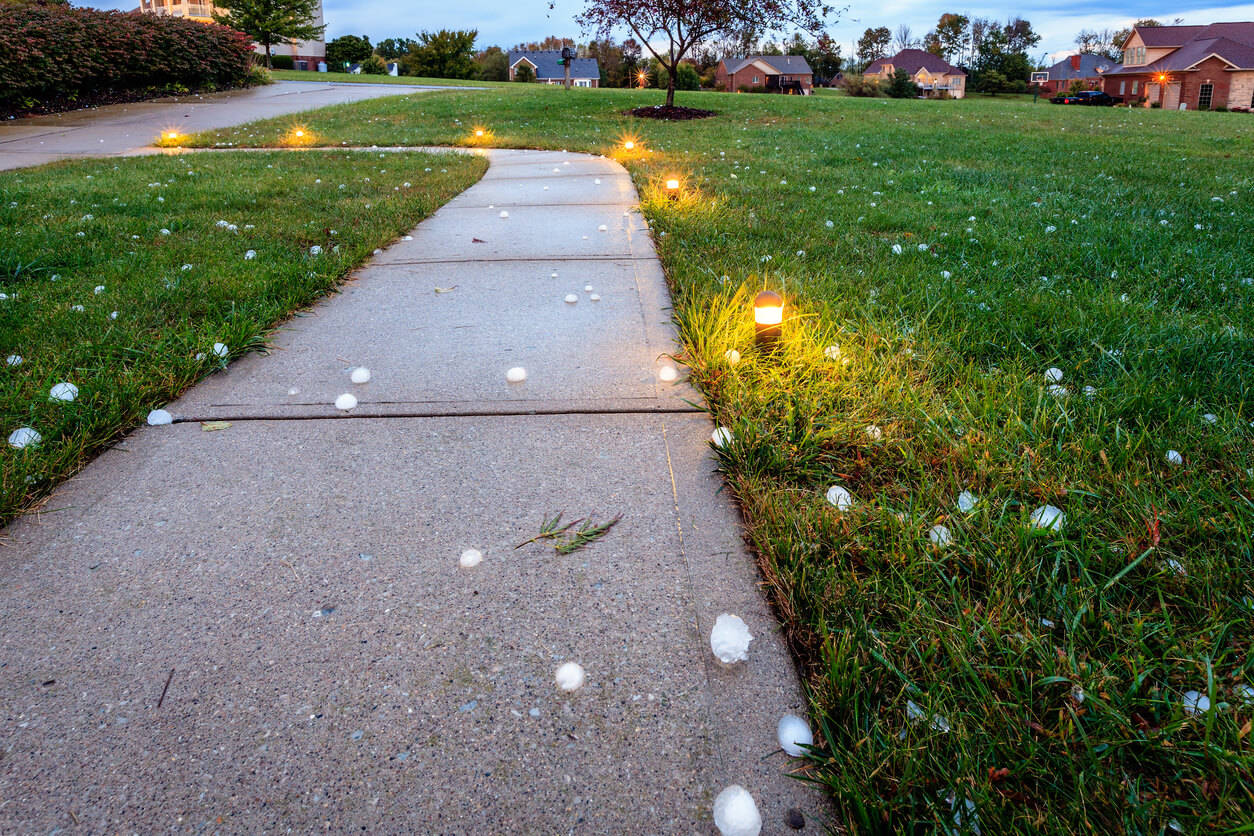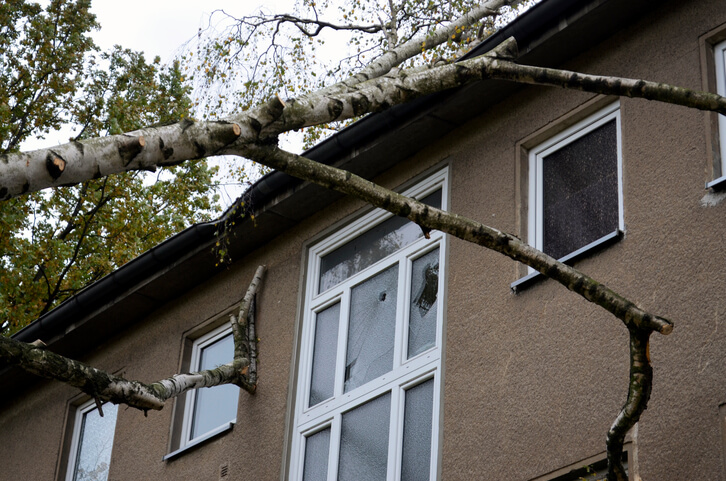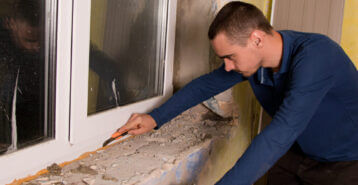Are you doing a windows project?
Modernize can pair you with three to four pros in your area, so you can compare options and save time and money.
Because your windows keep you safe from the outside elements, they are one of the most important features of your home. If your windows are shattered or broken during a storm, they need to be replaced or repaired immediately to restore your privacy, safety, and comfort. But not all window damage is easy to see, and if it goes undetected, it can cause bigger issues — like structural or foundational damage — down the road.
If you have recently experienced a bad storm, you may see your neighbors repairing or replacing their windows. An insurance adjuster may also be speaking to homeowners in the area.
It’s important for homeowners to be able to identify damage after an event. No matter what type of storm you have experienced, learn to spot signs of damage.
How to Stay Safe and Assess Window Damage
Before inspecting the exterior of your home for damage, make sure the storm has passed and it is safe to be outside. If you see downed power lines, electrical hazards, or flooding, keep away from the area and immediately call 911.
Even if the coast is clear, continue to be aware of potential hazards — especially on or near your roof. This is often the most dangerous place for post-storm damage as it can cause structural issues and is out of your line of vision. Check for fallen trees or heavy debris, loose or broken shingles, and ice dams if it’s a winter storm.
How To Check for Signs of Hail Storm Damage
Hail damage is easy to detect since hail can leave dents in your siding, roof, and car the size of a golf ball. Hail can also easily break or damage windows.
You will hear hail hitting your roof and windows and see pellets of ice gathering on the ground.
Hail damage usually causes the following damage to your home’s windows:
- Shattered or broken glass
- Broken, dented, or torn screens
- Cracked glazing
- Dented flashing above window or frame
How To Check for Signs of Wind Damage
High wind speeds have the potential to knock over trees, damage roofs, and — in severe cases — even shatter unsecured windows. After a heavy windstorm, check on the exterior of your home for:
- Shattered or broken panes
- Cracks, holes, or dents in glass
- Damaged or dented frames
- Chipped or cracked paint, siding, or wood
How to Look for Signs of Water Damage
Shattered glass and dents from hail and wind damage can be quickly identified, but the effects of water damage can be easily missed by an untrained eye. Untreated water damage and leaks can lead to mold, which can affect your home’s foundation and structure.
Here are the most important places to check for signs of flooding, leakage, and general storm damage.
Find the Right Contractor for Your Windows Project
Whether you’re ready to begin your project now or need some expert advice, our network of contractors are here to help. With a few simple questions, we’ll find the best local professionals for you
- Windows: Look for moisture buildup (fog) between glass panes
- Ceiling: Check for water spots, and yellow, copper, or brown discoloration
- Walls: Inspect for signs of cracking, peeling, or bubbling in the paint or wallpaper.
- Check your attic, basement, and crawl spaces for leaks or a damp, musty smell, which can occur as soon as 24-48 hours after a storm.
- Flooring: Examine for gaps or curling floorboards, sagging wood that feels soft to the touch, or expansion of wood and laminate floors, which occurs when the material becomes waterlogged.
Contacting Your Insurance and a Finding a Windows Contractor
If you detect any of the damage above, it is important to contact your homeowners’ insurance and find a windows contractor to help stop future damage and repair your home.
1. Document the Damage
Before you touch anything, take detailed notes and multiple photos of all damage to the area — both interior and exterior. This documentation will be important when you submit your insurance claim.
2. Safe-Proof Potential Hazards
Cover or board up any windows with shattered or jagged glass that could be a danger.
3. Submit Your Claim
The next step is to report the damages to your insurance company as soon as possible.
Time is of the essence when submitting a claim. Insurance companies have a limit of filing claims within one year of the damage. It is best to contact your insurance company by phone as well as email.
Document all your contact in a folder to help keep conversations, details, and dates organized. Submit your photo documentation and any receipts you’ve incurred along the way (for example, proof of your housing if the storm made your home temporarily uninhabitable).
4. Make an Appointment with an Insurance Adjuster
The insurance company will arrange an appointment for an adjuster to come out to your home and assess the damage. It is very important that you get three to four contractor estimates before you meet with the adjuster so that you have a professional benchmark for the project cost. Make sure your appointment with the adjuster will give you enough time to get contractor estimates first.
5. Get in Touch with a Trusted Window Contractor
Now it’s time to contact a few trusted contractors. They will assess the repair or window replacement cost and offer complimentary project quotes that you’ll give to your claims adjuster at your appointment. Most contractors have experience with storm-damaged homes, so it’s wise to ask your contractor to be present to make sure you get a fair assessment.
Modernize now offers homeowners a free digital Contractor Checklist as a simple step-by-step guide to assist with your windows project.
6. Replace or Repair
Depending on the severity of the damage, your contractor will suggest either a window repair or window replacement. Any changes in the original estimate should be recorded in writing. The project is finished after it has passed a city inspection and you’re satisfied with the completed work to your home’s windows.
If you live in an area with high-impact storms, consider storm windows, which are installed overtop your current windows as an extra barrier against the elements.
Find the Right Contractor for Your Windows Project
Whether you’re ready to begin your project now or need some expert advice, our network of contractors are here to help. With a few simple questions, we’ll find the best local professionals for you
Reviews from Real Homeowners
Welcome to Homeowner Resources! We are the Modernize blog. Modernize pairs more than 3 million homeowners a year with pre-vetted contractors in their area. This blog started because we believe homeowners should know everything about their homes, from how their HVAC works to which front door colors they might love. On Homeowner Resources, you can find information on every part of your home, right down to how you can negotiate with contractors to get the best price. Here's more about the blog.
Need a contractor? Learn more about how Modernize finds the right pro for you.









